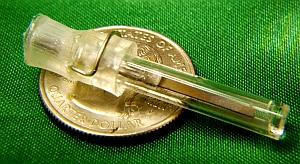Engineers at Purdue University in Indiana have developed a miniature medical sensor that can be powered by vibrations from music played nearby, with the deep bass of rap music found most effective. The research conducted in the lab of Babak Ziaie, professor of electrical and computer engineering and biomedical engineering, will be presented at the IEEE MEMS (microelectromechanical system) conference on 30 January. A patent has been filed for the device as well.
The miniature sensor (pictured right) is designed to be implanted in the body and measure blood pressure or pressure of urine in the bladder. Inside the sensor, a vibrating cantilever is a thin beam attached at one end like a miniature diving board. Music within a frequency range of 200-500 hertz causes the cantilever to vibrate, generating electricity and storing a charge in a capacitor. “The acoustic energy from the music can pass through body tissue, causing the cantilever to vibrate,” says Ziaie.
Vibrations reaching that range would likely be intermittent, thus when the frequency falls outside of the proper range, the cantilever stops vibrating, automatically sending an electrical charge to the sensor. The device then takes a pressure reading and transmits data as radio signals. If music is used to generate the vibrations, the constantly changing frequency of the music allows the sensor to to repeatedly alternate intervals of storing charge and transmitting data.
The sensor is about 2 centimeters long. Its cantilever beam is made from a ceramic material called lead zirconate titanate, a material that generates electricity when compressed. A receiver that picks up the data from the sensor could be placed several inches from the patient.
Ziaie’s team tested the sensor — now in an early prototype — in a water-filled balloon with plain audio tones and different types of music. Plain audio tones provided the frequencies needed to induce the powering vibrations, but they would likely be less pleasant, if not plain annoying, to patients than music.
Researchers experimented with four types of music: rap, blues, jazz and rock. “Rap is the best because it contains a lot of low frequency sound, notably the bass,” says Ziaie.
The researchers believe the device could be used diagnose incontinence. Current diagnostics call for inserting a probe with a catheter, which must be in place for several hours while the patient remains at the hospital. “A wireless implantable device could be inserted and left in place,” Ziaie notes, “allowing the patient to go home while the pressure is monitored.”
Read more: Driver Health Monitors Developed for Passenger Cars
* * *


 RSS - Posts
RSS - Posts
[…] Read more: Medical Sensor Powered by Music Vibrations Developed […]